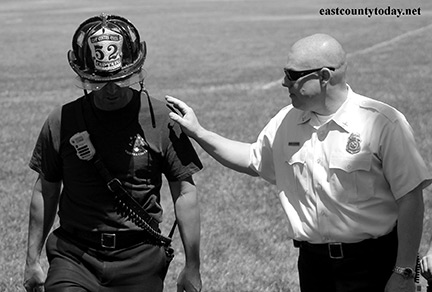SACRAMENTO – Governor Gavin Newsom today signed into law three bills that focus on improving protections for California’s workers around mental health and post-traumatic stress for the state’s firefighters and first responders.
The bills will create peer support programs, add post-traumatic stress suffered on the job as an “injury” for worker’s compensation purposes and ensure emergency services remain under public management for appropriate and consistent response to emergency situations.
“The job of firefighters and first responders can be very rewarding, but at the same time, extremely unpredictable. They can experience high-stress situations and traumatic incidents that can push them to the limit both physically and mentally, and we need to recognize and take those challenges head on,” said Governor Newsom. “These bills are meant to ensure they have access to resources and help in their time of need, in the same way they assist their communities when they need them most.”
AB 1116, the California Firefighter Peer Support and Crisis Referral Services Act by Assemblymember Tim Grayson (D-Concord), establishes statewide standards for first responder peer support programs to provide an agency-wide network of peer representatives available to aid fellow employees on emotional or professional issues.
“In 2017 when our state experienced some of the deadliest wildfires in its history, more California firefighters died by suicide than in the line of duty. Today we offer a life-line to these brave women and men who might otherwise suffer in silence,” said Assemblymember Grayson, who has also served as a Critical Response Chaplain for more than a decade. “I want to thank Governor Newsom for signing AB 1116 into law and joining me in prioritizing the mental health of our first responders.”
In addition, SB 542, the Trauma Treatment Act, by Senator Henry Stern (D-Canoga Park), will provide first responders with workers’ compensation while they recover from their mental health scars. SB 542 will improve mental health awareness among firefighters and law enforcement officers by establishing a rebuttable presumption of injury for firefighters and law enforcement personnel in instances where they sustain occupational post-traumatic stress.
“Every day, we ask firefighters and law enforcement officers to run into flames and gunfire – but too often, when the weight of these traumas becomes too much for these heroes to bear, we turn a blind eye to their struggles,” said Senator Stern. “Our nation has lost more public safety officers to suicide than in the line of duty— when just one life cut short is itself too many. Today, California is making clear that post-traumatic stress is not a disorder to be stigmatized. These injuries can be healed.”
Finally, SB 438 by Senator Robert Hertzberg (D-Van Nuys) will prohibit a public agency from outsourcing its local emergency dispatch services to a private, for-profit entity – except when pursuant to a joint powers or cooperative agreement. It also clarifies that a public safety agency maintains the authority to determine the appropriate deployment of emergency resources within the agency’s jurisdiction in order to provide the highest and best level of emergency response for the community it serves.
“The most sacred mission of government at any level is protecting the lives and health of its people. SB 438, which will ensure that the responsibility of public safety agencies to deploy a rapid response in an emergency will not be influenced by anyone’s bottom line,” said Senator Hertzberg.
Governor Newsom has taken several additional actions this year to assist firefighters across the state, including:
- Expanded CAL FIRE’s health and wellness program to provide medical and psychological services as well as peer support to firefighters,
- Invested nearly $1 billion in the state budget for emergency preparedness and response, including 13 new fire engines,
- Invested $127.2 million to expand CAL FIRE’S fleet with C-130 air tankers and modified Black Hawk helicopters for nighttime firefighting operations,
- Signed an executive order authorizing the surge of almost 400 seasonal firefighters to CAL FIRE this year,
- Identified and accelerated implementation of 35 priority fuel reduction projects to protect over 200 of California’s most at-risk communities using existing forest health and fire prevention funding,
- Redirected up to 100 California National Guard personnel to create fuel reduction and fire suppression crews that are available to CAL FIRE to undertake priority projects,
- Began overdue modernization of California’s 9-1-1 system,
- Working with California’s congressional delegation to secure the state’s eligibility for $12.6 billion in federal funding for disaster relief,
- Announced the selection of the first two contracts for the Wildfire Innovation Sprint, intended to modernize the way the state contracts for acquisition and development of technology systems, with the goal of getting cutting-edge firefighting technology in the hands of emergency responders by next fire season,
- Supporting local fire operations, including $2 million for the Butte County Fire Department to maintain its current level of service and continue operation of one year-round fire station through its cooperative agreement with CAL FIRE,
- Partnered with the Federal Government to secure state access to remote sensor-based technology to detect wildfire ignitions, including securing delegation of authority from the Secretary of Defense to fly infrared equipped Unmanned Aerial System in support of CAL FIRE missions,
- Invested $210 million Greenhouse Gas Reduction Fund for forest health and fire prevention projects and programs to enable CAL FIRE to complete more fuel reduction projects and increase the pace and scale of fire prevention, and
- Developed and implemented the Forestry Corps Program, to operate four Forestry Corps crews that will undertake forest health and hazardous fuel reduction projects in areas of high fire risk.


1 comment
Shocking considering he stands against the Police. Probably only applies to real 1st responders, “Firefighters.”
Comments are closed.